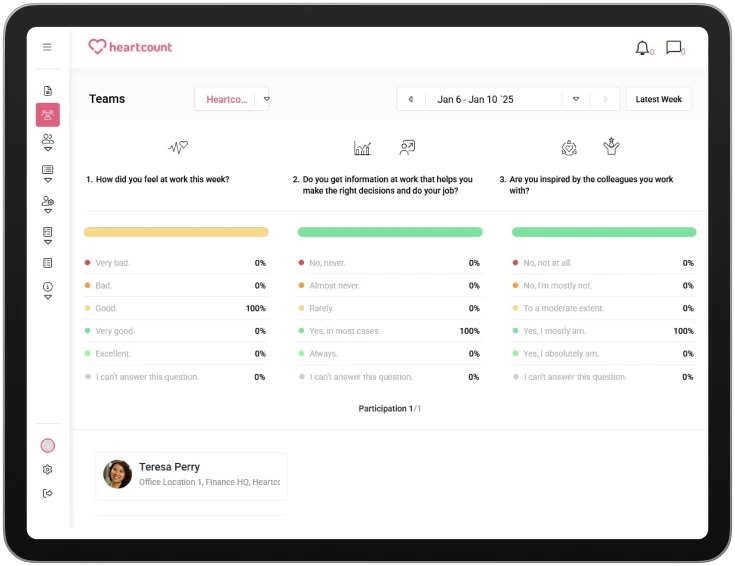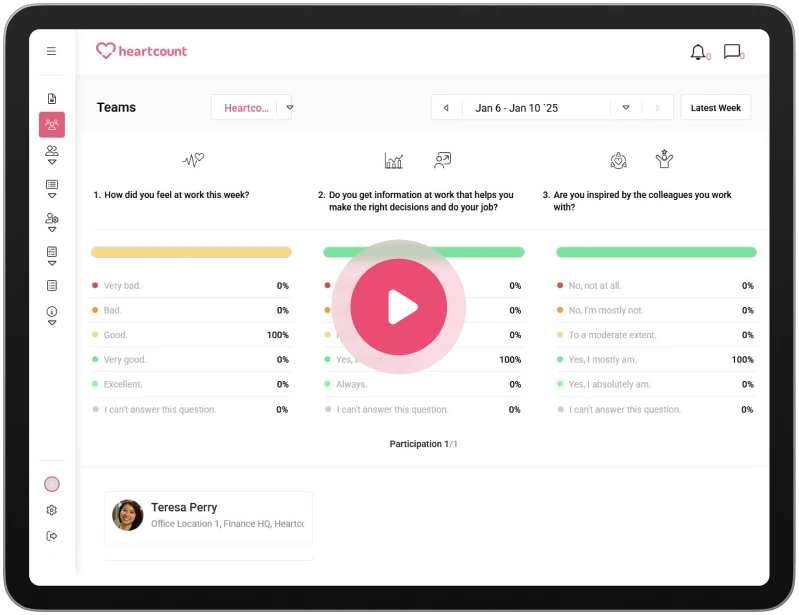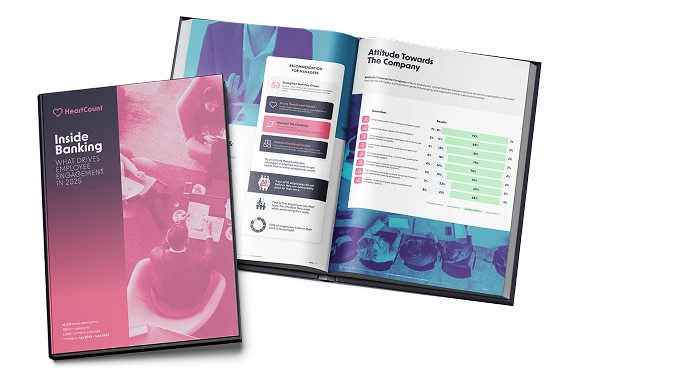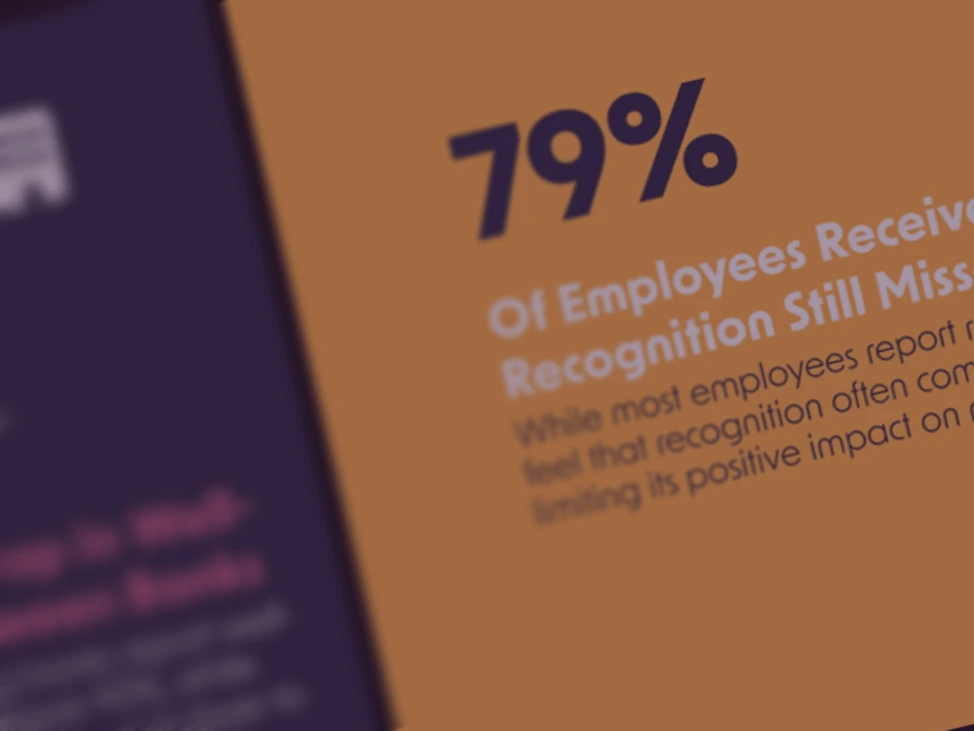Performance Review Questions: 30+ High-Impact Prompts for Meaningful Conversations

Performance reviews have been debated for decades, yet they remain one of the most influential tools for shaping culture and performance. The problem is not the process itself. It is how often reviews fail to turn feedback into meaningful change. This usually stems from relying on generic or misaligned performance review questions, which don’t connect to the real work or team priorities.
Academic research shows that feedback quality makes a measurable difference to outcomes. A landmark meta-analysis on feedback interventions found that more than a third of them actually reduced performance when the guidance was vague or focused on personality instead of behaviour. In contrast, structured, participative reviews lead to stronger motivation and a higher sense of fairness.
In an era of hybrid work, shifting priorities and rising burnout, managers need sharper tools. So, what are good performance review questions in 2025? They are open-ended, contextual, and designed to prompt meaningful reflection, the kind that drives progress and trust, not just documentation.
At HeartCount, we believe that performance conversations should be continuous, contextual, and people-first. This guide brings together 30 performance review questions that help managers move beyond routine check-ins. Use them to create consistent, constructive conversations that balance accountability with growth and make feedback a continuous part of how your team works.
-
1.Why Performance Review Questions Still Matter in 2025
-
2.30 Performance Review Questions for Meaningful Employee Conversations
-
3.Making Performance Reviews More Valuable (Not Just a Checkbox)
-
4.Bonus: Performance Review Questions for Managers to Self-Reflect
-
5.Making Performance Reviews More Valuable (Not Just a Checkbox)
-
6.Turn Insights Into Action With Continuous Reviews
-
7.FAQs About Performance Review Questions
Performance reviews have been debated for decades, yet they remain one of the most influential tools for shaping culture and performance. The problem is not the process itself. It is how often reviews fail to turn feedback into meaningful change. This usually stems from relying on generic or misaligned performance review questions, which don’t connect to the real work or team priorities.
Academic research shows that feedback quality makes a measurable difference to outcomes. A landmark meta-analysis on feedback interventions found that more than a third of them actually reduced performance when the guidance was vague or focused on personality instead of behaviour. In contrast, structured, participative reviews lead to stronger motivation and a higher sense of fairness.
In an era of hybrid work, shifting priorities and rising burnout, managers need sharper tools. So, what are good performance review questions in 2025? They are open-ended, contextual, and designed to prompt meaningful reflection, the kind that drives progress and trust, not just documentation.
At HeartCount, we believe that performance conversations should be continuous, contextual, and people-first. This guide brings together 30 performance review questions that help managers move beyond routine check-ins. Use them to create consistent, constructive conversations that balance accountability with growth and make feedback a continuous part of how your team works.
Why Performance Review Questions Still Matter in 2025
In a work landscape defined by hybrid teams, shifting priorities, and rising burnout, performance conversations aren’t just about ratings anymore, they’re a vital touchpoint for alignment, support, and employee growth. When done well, employee performance review questions can build trust, uncover blind spots, and open the door to deeper growth, not just evaluation.
A growing body of research points to how structured feedback and open dialogue can improve employee outcomes, especially when team members feel psychologically safe to share honestly. Harvard Business School highlights how asking thoughtful, forward-looking questions helps reduce the anxiety often associated with reviews and creates space for reflection and problem-solving.
How Employee Conversations Are Evolving
Traditional reviews focused heavily on past performance, but modern teams need something more dynamic. Employees today expect to be part of the conversation, not just the subject of it. When they’re invited to reflect, share feedback, and identify next steps collaboratively, reviews become a shared opportunity instead of a one-sided judgement.
Younger employees in particular value coaching-style conversations over rigid formats. They’re looking for recognition, clarity, and real-time course correction, not just an annual sit-down. That’s why flexible, high-quality questions play such a key role in supporting evolving expectations.
The Shift From Annual Reviews to Continuous Dialogue
The move away from once-a-year reviews is no longer just a trend. It’s fast becoming best practice. Bodies like CIPD (Chartered Institute of Personnel and Development) now recommend frequent check-ins and goal recalibration over static performance cycles. This shift reflects what teams already feel: a lot can change in three months, let alone twelve.
For managers navigating that pace, tools that support automated employee pulse check surveys make it easier to stay in sync with their teams. Instead of relying on memory or end-of-year summaries, they can bring fresh context into every conversation, grounded in how people are actually doing week to week.
30 Performance Review Questions for Meaningful Employee Conversations
Not all performance review questions lead to real insight. The best ones create space for reflection, uncover friction, and help both people align on what’s next. These questions to ask during performance review are designed to spark dialogue that’s constructive, not performative.
You don’t need to ask every question in one sitting. Choose the ones that fit your conversation: end-of-quarter, mid-year, post-project, or part of a weekly feedback rhythm.
Whether it’s a formal check-in or a regular one-on-one, these questions to ask employee during performance review help you frame better feedback and uncover what they might not say unprompted.
This guide brings together 30 of the best performance review questions we’ve seen spark real conversations across different roles, seniority levels, and teams.
Overall Performance and Role Clarity
Start by grounding the conversation in how the employee sees their contributions. These questions help uncover what feels clear, what doesn’t, and how confident they are about recent outcomes.
1) How would you assess your performance this quarter?
This sets the tone for a two-way conversation and shows how self-aware the employee is about their work. You’ll learn what they value, how they define success, and where they might already be self-correcting. It also helps you spot disconnects between their perception and yours early in the conversation.
2) What part of your role feels most clear and what feels ambiguous?
This helps uncover hidden misalignments that slow down productivity. Clarity directly impacts confidence, ownership, and how well someone prioritises day to day. If left unspoken, ambiguity can lead to duplicated work or missed expectations.
3) Which outcomes are you most and least confident about and why?
Confidence is often shaped by support, tools, and feedback. This question reveals where someone feels strong and where coaching or process fixes could help. It also helps you identify blind spots or low-confidence wins that deserve more visibility.
4) Where did you exceed expectations and where did you fall short?
Framing both sides encourages honest reflection without defensiveness. It also gives you language to validate wins and explore accountability together. Their answer can help you understand how they interpret feedback and whether they’re aligned with the team’s standards.
Strengths and Skills
Understanding how an employee applies their strengths is key to unlocking consistent, high-quality performance. These questions help you assess which capabilities are currently driving impact, where potential may be underused, and how skills can be developed in line with team needs. This section also supports more targeted recognition and better-informed development planning.
5) What strengths have you relied on most recently?
Helps reinforce positive identity and invites you to recognise what’s driving their success. Also makes it easier to connect their impact to team outcomes. Knowing what they lean on most can inform future project assignments and recognition.
6) What new skill are you proud of building?
This gives visibility to behind-the-scenes growth and signals that learning is valued. It can also reveal where someone is pushing themselves without being asked. Their answer may point to emerging capabilities you hadn’t noticed yet.
7) Which strengths are underused in your current role?
Great for spotting untapped potential or early signs of disengagement. If someone’s best skills are on the bench, that’s a retention risk waiting to happen. It also helps you think more creatively about how to stretch or re-scope responsibilities.
8) Which skills should we invest in next?
Helps shape development plans that feel personalised and practical. Employees are more likely to engage with learning if they’ve helped define the goal. This question also gives you insight into where they want to grow versus where the business needs them to grow.
Areas for Growth and Support
Every role has friction points. These prompts help identify where things feel hard, inefficient, or unsupported, and how you can help clear the way.
9) Where have you struggled or needed more support?
Normalises asking for help and reduces stigma around challenges. It also makes it easier to offer practical support instead of vague encouragement. Over time, this question helps establish psychological safety in regular check-ins.
10) What would help you perform better?
Shifts the review from feedback to problem-solving. It encourages agency and identifies what’s within your control as a manager. Even small changes in structure, expectations, or communication can come out of this prompt.
11) Which processes or tools slow you down the most?
Great for exposing inefficiencies you may not notice from above. If multiple people flag the same thing, it could point to a larger system issue. This prompt also signals that your team is empowered to challenge the status quo.
12) What one habit would have the biggest impact if improved?
Focuses attention on behaviour over personality. Also useful for setting a small, achievable goal with real payoff. It opens the door to coaching without making the feedback feel personal or overwhelming.
Collaboration and Team Dynamics
Work rarely happens alone. Use these prompts to explore how the employee experiences teamwork, handoffs, and communication. You can also encourage input on ways the team could collaborate more smoothly.
Many of the frictions in team dynamics come down to habits, structure, or alignment. A strong culture of collaboration doesn’t just improve productivity. It also gives people more clarity and trust in how they work together.
13) How do you feel about team communication?
Communication breakdowns are one of the most common performance bottlenecks. This helps you spot where things are smooth and where signals get dropped. It also gives you insight into whether team members feel heard and looped in on decisions that affect them.
14) Where do you see potential for better collaboration?
Encourages constructive thinking about teamwork without finger-pointing. Also invites employees to suggest fixes from their own lived experience. This can lead to process improvements or role adjustments that benefit the whole team.
15) Whose work do you depend on most and how can handoffs improve?
Brings visibility to cross-functional dependencies. Handoff quality often determines how fast things move and how frustrated people feel. The answer may also highlight training needs or unclear ownership between teams.
16) What has worked best when this team resolves conflicts?
Keeps the tone positive while still addressing tension. You learn what resolution styles feel safe and effective to the team. These insights can guide how you facilitate future conflicts and set team norms.
Manager Feedback and Leadership
This is a chance to ask how you’re doing as a manager. These prompts create space for upward feedback, while also modelling the kind of openness you’re asking of them.
If you’re running regular check-ins or one-to-ones, you’ll find some crossover with these manager-led conversation starters that can deepen the discussion and surface more useful feedback.
17) How supported do you feel by your manager?
A simple but powerful way to assess your own impact. If the support doesn’t feel visible, it might as well not exist. This also helps uncover mismatches between your intent and how your actions are actually received.
18) What feedback would you give your manager?
Promotes a culture of two-way feedback and helps you grow as a leader. It also builds trust when you model openness. When asked consistently, this question encourages accountability at every level.
19) What one change from me would help you most?
Keeps the feedback specific, actionable, and not overwhelming. Even small adjustments can improve how you work together. This also shows that you’re willing to adapt, not just coach.
Career Development and Future Goals
Growth conversations don’t need to wait for promotion cycles. These questions open the door to future planning, whether someone’s actively preparing for the next step or just starting to explore what’s possible. They also help align personal goals with business needs and show that you’re invested in long-term development, not just short-term output.
20) What does your next step at this company look like?
This helps clarify their ambitions and what they see as a natural progression. You’ll get insight into their career drivers and whether they feel like upward movement is possible here.
21) Are there projects you would like to take on in the next 6 to 12 months?
Great for uncovering development opportunities that align with actual business needs. It also tells you how proactive someone is about their own growth and what kind of stretch work excites them.
22) Which skills or experiences will prepare you for that step?
Helps you support their goals with specific development actions, not vague encouragement. This question often reveals where coaching, shadowing, or formal training might make the biggest difference.
23) What milestones should we set for the next quarter?
Brings the career conversation down to something practical and time-bound. It gives your feedback loop a direction and helps you track real progress between reviews.
Engagement and Energy
Burnout doesn’t always show up in metrics. These prompts help you understand how someone’s feeling at work, what gives them energy, and how you can support their day-to-day experience more meaningfully.
24) How have you been feeling at work lately?
This question invites a check-in without forcing vulnerability. It helps you catch early signs of disengagement, stress, or isolation that might not show up in performance metrics. If answered honestly, it can shape how you pace support or interventions in the weeks ahead.
25) What energises you and what drains you?
A strong prompt for understanding workload fit and emotional fatigue. It gives you practical insight into how to rebalance responsibilities and sustain motivation. Over time, answers to this can guide task assignment, recognition, and team design.
26) When do you feel most focused during the week?
Useful for aligning deep work with natural energy patterns. It can also help you adjust meeting times, deadlines, or expectations to support peak performance. When asked regularly, it helps build better working rhythms across the team.
27) What would make your day-to-day work more satisfying?
This question often uncovers small but meaningful changes that improve experience and retention. It also helps you tailor your support beyond compensation or role changes. Many of the best ideas for improving team culture come from answers to this exact prompt.
End-of-Period Reflections
These wrap-up prompts bring the conversation full circle. Use them to help the employee reflect, celebrate wins, and set the tone for the next stretch ahead.
28) What are you most proud of this year?
This question helps you understand what the employee values in their own work. It also highlights moments that mattered to them but may not have been recognised formally. Their answer can guide how you offer praise and what kind of work feels most fulfilling to them.
29) What is one thing you would like to do differently next quarter?
Promotes self-reflection without triggering defensiveness. It invites a specific improvement while keeping the focus on progress. You’ll also learn whether their instincts for growth align with your own observations.
30) What was your biggest lesson and how will you apply it?
This turns experience into intentional action. It encourages employees to reflect on how they’ve grown and sets a clear link between past reflection and future behaviour. It also gives the review a natural sense of closure and direction.
COLLECT
Making Performance Reviews More Valuable (Not Just a Checkbox)
Performance reviews often fall flat when they feel rushed, vague, or disconnected from the real work people are doing. But when used intentionally, they can become meaningful checkpoints for clarity, recognition, and progress. The difference usually comes down to asking the right questions for performance review, the kind that prompt reflection, build trust, and connect feedback to growth.
Use Questions to Spark Alignment, Growth, and Trust
When reviews are built around thoughtful prompts, the conversation shifts. Instead of feeling like a performance evaluation, it becomes a chance to align on goals, explore blockers, and build trust. Good questions open space for people to share what’s working, what’s not, and where they want to grow.
Even when the topic is tough, like a missed target or a drop in quality, questions can keep the tone constructive. They turn the focus from blame to problem-solving.
Connect Questions to Real-Time Team Data
Review questions land better when they’re grounded in what’s actually happening on the team. If a manager can reference patterns from the past few weeks instead of relying on memory, the conversation becomes sharper and more useful.
With access to data-driven insights, it’s easier to highlight emerging trends, spot silent issues, or give timely praise. Questions feel less like guesswork and more like leadership.
How HeartCount Enables Always-On Feedback Loops
HeartCount helps managers stay close to team sentiment through weekly pulse surveys and nudges. Instead of saving feedback for quarterly reviews, it becomes a continuous conversation, the so-called feedback loop. Managers get notified when signals shift, and employees have regular space to reflect.
That rhythm makes performance reviews easier to prepare for and harder to ignore. They are no longer big, high-pressure meetings. They are part of an ongoing loop that supports growth all year long.
Bonus: Performance Review Questions for Managers to Self-Reflect
Performance reviews are a two-way mirror. While it’s important to guide employees through meaningful conversations, it’s just as valuable to pause and examine your own leadership. These prompts help you reflect on how you’re showing up, where your team might need more from you, and how to improve the experience you’re creating.
You can revisit these questions quarterly or after major team milestones to keep your leadership evolving. If you want to go deeper, try incorporating them into your leadership development strategy with clear, intentional goals.
Am I Creating Space for Honest, Useful Conversations?
Are team members opening up during reviews or holding back? Reflecting on psychological safety can help you adjust your approach to feedback and follow-up.
Do I Follow Up on Feedback or Just File It Away?
If employees share ideas or concerns but never see change, trust erodes quickly. Consider whether you’re closing the loop on what they tell you.
What Trends Am I Noticing Across My Team?
Review conversations often reveal patterns: repeated blockers, burnout signals, or missed opportunities. Identifying these early helps you lead with more awareness and impact.
Making Performance Reviews More Valuable (Not Just a Checkbox)
Performance reviews often fall flat when they feel rushed, vague, or disconnected from the real work people are doing. But when used intentionally, they can become meaningful checkpoints for clarity, recognition, and progress. The difference usually comes down to asking the right questions for performance review, the kind that prompt reflection, build trust, and connect feedback to growth.
Use Questions to Spark Alignment, Growth, and Trust
When reviews are built around thoughtful prompts, the conversation shifts. Instead of feeling like a performance evaluation, it becomes a chance to align on goals, explore blockers, and build trust. Good questions open space for people to share what’s working, what’s not, and where they want to grow.
Even when the topic is tough, like a missed target or a drop in quality, questions can keep the tone constructive. They turn the focus from blame to problem-solving.
Connect Questions to Real-Time Team Data
Review questions land better when they’re grounded in what’s actually happening on the team. If a manager can reference patterns from the past few weeks instead of relying on memory, the conversation becomes sharper and more useful.
With access to data-driven insights, it’s easier to highlight emerging trends, spot silent issues, or give timely praise. Questions feel less like guesswork and more like leadership.
How HeartCount Enables Always-On Feedback Loops
HeartCount helps managers stay close to team sentiment through weekly pulse surveys and nudges. Instead of saving feedback for quarterly reviews, it becomes a continuous conversation, the so-called feedback loop. Managers get notified when signals shift, and employees have regular space to reflect.
That rhythm makes performance reviews easier to prepare for and harder to ignore. They are no longer big, high-pressure meetings. They are part of an ongoing loop that supports growth all year long.
UNDERSTAND
Turn Insights Into Action With Continuous Reviews
Performance reviews shouldn’t be the end of the conversation. They should be the start of real momentum. Turning insights into action means following up, setting clear goals, and keeping feedback alive long after the meeting ends.
This is where continuous feedback loops shine. When reviews are paired with regular check-ins, pulse data, and nudges, they’re more likely to result in measurable progress. It becomes easier to see what’s working, spot gaps, and stay responsive to change.
Why Waiting 12 Months Is Too Late
A lot can shift in a year: priorities, team dynamics, personal goals, and even role expectations. If feedback only happens once annually, it’s likely outdated or incomplete by the time it’s shared.
Ongoing performance conversations keep context fresh and make it easier to course-correct. They also reduce the pressure that builds up around formal reviews, especially when employees already know how they’re doing before the meeting starts.
How Pulse-Based Feedback Transforms Review Conversations
Pulse surveys provide a running log of how people are feeling, performing, and engaging over time. They help managers bring real data into performance conversations, instead of relying on memory or sporadic notes.
Tools like HeartCount support this rhythm through custom employee surveys and weekly sentiment tracking. That way, reviews aren’t disconnected events. They’re connected to what’s happening on the ground, in real time.
Using HeartCount to Spot Signals and Respond Faster
When you can see early signs of disengagement, burnout, or misalignment, it’s easier to take action before problems grow. HeartCount highlights these signals through AI-powered risk alerts, manager nudges, and ongoing feedback channels.
This allows teams to move from reactive to proactive. Performance conversations become part of a larger system that helps everyone stay aligned, supported, and focused on what matters most.
FAQs About Performance Review Questions
What are the best performance review questions to ask?
The best performance review questions are open-ended, clear, and encourage thoughtful reflection tied to outcomes. Focus on prompts that explore impact, growth, clarity, and collaboration. For example: What outcomes are you most proud of? Where do you feel stuck? What would help you do your best work?
What questions should managers ask employees?
Managers should ask questions that help employees reflect, feel heard, and identify next steps. Strong options include: What support do you need right now? What’s getting in your way? Where do you want to grow next? These kinds of prompts build trust and uncover useful insights.
What questions should employees ask their managers?
Employees can use review conversations to ask for clarity, feedback, or support. Some good performance review questions to ask manager include: “How do you see my performance this quarter?” or “What would you like me to prioritise next?”
How can I prepare for a performance review conversation?
Preparing ahead can help you stay confident and clear. Know your key wins and blockers, and get a sense of how to answer performance review questions so the conversation stays productive and future-focused.
How often should performance reviews happen?
The traditional annual review is giving way to more continuous feedback models. Many organisations now run quarterly check-ins supported by weekly pulse feedback. This keeps conversations timely, actionable, and grounded in real context.











